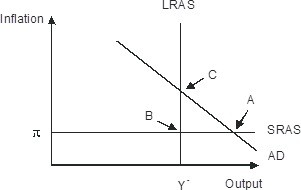If we assume competitive labor markets, the supply curve of labor when the firm is a monopoly is
A. horizontal.
B. upward sloping.
C. vertical.
D. downward sloping.
Answer: A
You might also like to view...
In 1933, net private domestic investment was negative $6.0 billion. This means that ________.
A. gross private domestic investment exceeded depreciation by $6.0 billion B. the production of 1933's GDP used up more capital goods than were produced in that year C. the economy was expanding in that year D. the economy produced no capital goods at all in 1933
Refer to the figure below. In response to gradually falling inflation, this economy will eventually move from its short-run equilibrium to its long-run equilibrium. Graphically, this would be seen as 
A. long-run aggregate supply shifting leftward B. Short-run aggregate supply shifting upward C. Short-run aggregate supply shifting downward D. Aggregate demand shifting leftward
Suppose you own some German government bonds that pay you interest every year. This interest is entered into which of the balance of payments accounts?
A) trade account B) interest account C) current account D) capital and financial account E) official settlements account
Pietro is a manager at a carwash. He has hired 10 workers to wash and detail cars for him and is considering what type of payment scheme he should set up for his workers. He can pay each of his workers $9 per hour to wash and detail cars, or he can pay
his workers $12 for each car a worker washes and details. (It takes 75 minutes, on average, for an employee to wash and detail a car.) If Pietro wants to maximize the number of cars his workers wash and detail in one day, which payment scheme should he use? Explain. What will be an ideal response?